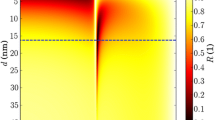Abstract
Moderate fluorescence from aluminium doped zinc oxide films is detected. It is shown that this defect-related fluorescence can be controlled for the films deposited on the gilded glass and attached to the semicylinder prism. Namely the changes in the spectral shape, intensity and polarization of fluorescence were detected for certain resonant angles in case of detection through the prism. Maxima in fluorescence intensity were obtained for detection angles corresponding to minima in light reflection. The strength of electric field inside the layered structure is calculated and analysed. On the basis of this analysis coupling of fluorescent light with hybrid waveguide-plasmonic and waveguide modes at resonant detection angles is considered as the cause for obtained directional fluorescence.







Similar content being viewed by others
References
Abeles, F.: Optical properties of thin absorbing films. J. Opt. Soc. Am. 47(6), 473–482 (1957). doi:10.1364/JOSA.47.000473
Badugu, R., et al.: Radiative decay engineering 6: fluorescence on one-dimensional photonic crystals. Anal. Biochem. 442(1), 83–96 (2013). doi:10.1016/j.ab.2013.07.021
Badugu, R., et al.: Fluorescence spectroscopy with metal–dielectric waveguides. J. Phys. Chem. C 119, 16245–16255 (2015). doi:10.1021/acs.jpcc.5b04204
Boiko, V., et al.: Angular shaping of fluorescence from synthetic opal-based photonic crystal. Nanoscale Res. Lett. 10, 97 (2015). doi:10.1186/s11671-015-0781-y
Calander, N.: Surface plasmon-coupled emission and fabry–perot resonance in the sample layer: a theoretical approach. J. Phys. Chem. B 109(29), 13957–13963 (2005). doi:10.1021/jp0510544
Chilwell, J., Hodgkinson, I.: Thin-films field-transfer matrix theory of planar multilayer waveguides and reflection from prism-loaded waveguides. J. Opt. Soc. Am. 1(7), 742–753 (1984). doi:10.1364/JOSAA.1.000742
Dong, Z., et al.: Fluorescent properties of ZnO nanostructures fabricated by hydrothermal method. J. Nanomater. 2012, 251276 (2012). doi:10.1155/2012/251276
Grandidier, J., et al.: Leakage radiation microscopy of surface plasmon coupled emission: investigation of gain-assisted propagation in an integrated plasmonic waveguide. J. Microsc. 239(2), 167–172 (2010). doi:10.1111/j.1365-2818.2010.03368.x
Gryczynski, I., et al.: Radiative decay engineering 4. Experimental studies of surface plasmon-coupled directional emission. Anal. Biochem. 324(2), 170–182 (2004). doi:10.1016/j.ab.2003.09.036
Hakala, T., et al.: Vacuum rabi splitting and strong-coupling dynamics for surface-plasmon polaritons and rhodamine 6G molecules. Phys. Rev. Lett. 103, (053602-1)–(053602-4) (2009). doi:10.1103/PhysRevLett.103.053602
Jungwirth, N., et al.: A single-molecule approach to ZnO defect studies: single photons and single defects. J. Appl. Phys. 116, 043509 (2014). doi:10.1063/1.4890979
Kondratiev, V., et al.: Low temperature sol–gel technique for processing Al-doped zinc oxide films. Mater. Phys. Mech. 17(1), 38–46 (2013). http://www.ipme.ru/e-journals/MPM/no_11713/MPM117_08_kondratiev.pdf
Kretschmann, E., Raether, H.: Radiative decay of non-radiative surface plasmons excited by light. Z. Naturforsch. 23A, 2135–2136 (1968)
Lackowicz, J.: Radiative decay engineering: biophysical and biomedical applications. Anal. Biochem. 298, 1–24 (2001). doi:10.1006/abio.2001.5377
Lakowicz, J.: Radiative decay engineering 3. Surface plasmon-coupled directional emission. Anal. Biochem. 324(2), 153–169 (2004). doi:10.1016/j.ab.2003.09.039
Liu, H., et al.: Transparent conducting oxides for electrode applications in light emitting and absorbing devices. Superlattice Microstruct. 48, 458–484 (2010). doi:10.1016/j.spmi.2010.08.011
Liu, F., Nunzi, J.: Enhanced organic light emitting diode and solar cell performances using silver nano-clusters. Org. Electron. 13(9), 1623–1632 (2012). doi:10.1016/j.orgel.2012.04.027
Loot, A., et al.: Goniometric setup for plasmonic measurements and characterization of optical coatings. In: Fesenko, O., Yatsenko, L., Brodin, M. (eds.) Nanomaterials Imaging Techniques, Surface Studies, and Applications Springer Proceedings in Physics, vol. 146, pp. 130–145. Springer, New York (2013). doi:10.1007/978-1-4614-7675-7. ISBN 978-1-4614-7674-0
Noginov, M., et al.: Stimulated emission of surface plasmon polaritons. Phys. Rev. Lett. 101, 226806 (2008). doi:10.1103/PhysRevLett.101.226806
Oulton, R., et al.: A hybrid plasmonic waveguide for subwavelength confinement and long-range propagation. Nat. Photonics 2, 496–500 (2008). doi:10.1038/nphoton.2008.131
Purcell, E.: Spontaneous emission probabilities at radio frequencies. Phys. Rev. 69, 681 (1946)
Rakić, A., et al.: Optical properties of metallic films for vertical-cavity optoelectronic devices. Appl. Opt. 37(22), 5271–5283 (1998)
Ray, K., et al.: Plasmon-controlled fluorescence towards high-sensitivity optical sensing. Adv. Biochem. Eng. Biotechnol. 116, 29–72 (2010). doi:10.1007/10_2008_9
Sainidou, R., et al.: Extraordinary all-dielectric light enhancement over large volumes. Nano Lett. 10, 4450–4455 (2010)
Santory, C.: Single defects in diamonds. In: Migdall, A., Polyakov, S., Fan, J., Bienfang, J. (eds.) Single Photon Generation and Detection Physics and Applications, vol. 45. Elsevier, Amsterdam (2013). ISBN 9780123876959
Seidel, J., et al.: Stimulated emission of surface plasmons at the interface between a silver film and an optically pumped dye solution. Phys. Rev. Lett. 94, 177401 (2005)
Stockman, M.: Spasers explained. Nat. Photonics 2, 327–329 (2008). doi:10.1038/nphoton.2008.85
Tumkur, T., et al.: Plasmon-mediated emission in the strong coupling regime. In: Proceedings of the CLEO: QELS_Fundamental Science 2015 conference FW3E.4 (2015), ISBN: 978-1-55752-968-8
Winter, G., Barnes, W.: Emission of light through thin silver films via near-field coupling to surface plasmon polaritons. Appl. Phys. Lett. 88, 051109 (2006). doi:10.1063/1.2170426
Yuk, J., et al.: Signal enhancement of surface plasmon-coupled emission (SPCE) with the evanescent field of surface plasmons on a bimetallic paraboloid biochip. Biosens. Bioelectron. 26, 3213–3218 (2011). doi:10.1016/j.bios.2010.12.028
Acknowledgements
This work was supported by the Estonian Research Council (institutional project IUT34-27) and partially by ETF9283, Marie Curie ILSES Project No. 612620 and NATO SPS project NUKR.SFPP984702.
Author information
Authors and Affiliations
Corresponding author
Rights and permissions
About this article
Cite this article
Dolgov, L., Kondratiev, V.I., Loot, A. et al. Resonant control of fluorescence from aluminium doped zinc oxide films. Opt Quant Electron 48, 522 (2016). https://doi.org/10.1007/s11082-016-0794-5
Received:
Accepted:
Published:
DOI: https://doi.org/10.1007/s11082-016-0794-5




